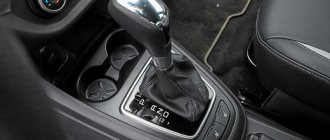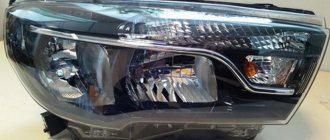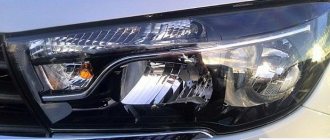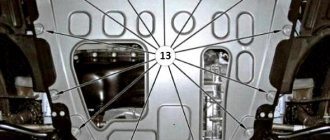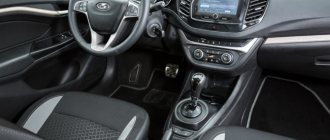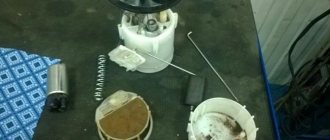Technical characteristics of Vesta AT
Previously, the car was equipped with a 1.6-liter 106-horsepower and 1.8 with 122 horsepower power units. "Lada Vesta" 113 l / with a variator not only received a new type of gearbox, but also a Japanese engine. The motor was developed by the Nissan Corporation, and is now produced by AvtoVAZ under the name H4M.
The appearance of the new model is no different from Vesta with mechanical and robotic transmission.
The body remains the same, the changes affect only the central tunnel, where the gearbox control knob is located.
"Vesta" with CVT orange. Photo source: https://xn--80aal0a.xn--80asehdb/auto-news/lada-vesta-news/5183-kakie-obnovlenija-poluchila-lada-vesta-s-variatorom.html
The CVT unit is larger in size and weight than a manual transmission, but the engineers managed to place the box in the body subframe without reducing ground clearance. The ground clearance remained the same - 178 mm, for the Vesta SW cross - 203 mm.
The variator is heavier than a manual transmission, the new engine is 8 kg lighter due to the use of an aluminum cylinder block. As a result, the curb weight of the car remained the same - 1.23 tons, maximum - 1.67.
Pros of a CVT
1. The JF015E variator has become lighter and more compact
(the ground clearance is the same as that of a car with a manual transmission, the transmission is recessed into the perimeter of the subframe, which eliminates damage when driving over large bumps in the road) than previous samples. This was achieved through a new design that uses a V-belt drive, a two-stage planetary gearbox with gears and a torque converter.
2. This variator design is not afraid of frost, slipping and heavy loads
.
3. The gearbox mechanism facilitates the loaded mode
like shifting into reverse gear and back. Now a special electronically controlled clutch is responsible for this. It equalizes the speed of rotation of the shafts, and reverse gear engages smoothly and clearly.
4. The use of a two-stage planetary gearbox made it possible to reduce the resistance when mixing transmission oil by 30%.
(this is especially true in cold weather, when the oil thickens).
5. The design eliminates dangerous moments from the operation of the variator
contact of the belt and cones at the edge or at the axle, where a breakdown could theoretically occur during sliding.
6. The variator cooling system is integrated into one circuit with the engine cooling system. This allows you to effectively maintain the operating temperature
of the transmission
in hot and cold weather.
7. A CVT is more economical than a manual transmission
by 0.2 l/100km (manual transmission - 7.5 l/100km, CVT - 7.3 l/100km).
8. Accelerates easily and smoothly, acceleration occurs without the slightest jerk
, which can be felt, one way or another, on any automatic transmission.
Smooth running is ensured by a torque converter, which is responsible for the clutch function, and a V-belt drive, which additionally smoothes out the loss of traction when switching in the gear section. 9. CVT settings keep engine speed low. It turns out that the engine runs almost silently
.
10. There is no need to change the oil in the variator
, it is designed for the entire period of operation.
CVT installed on Vesta AT
In 2010, Jatco, one of the divisions of Nissan Corporation, released a new CVT for cars with an engine capacity of no more than 1.8 liters. The transmission was designated JF015E. It replaced the JF011E, installed on more powerful power units.
"Vesta" with a CVT at the rear. Photo source: https://xn--80aal0a.xn--80asehdb/auto-news/lada-vesta-news/5183-kakie-obnovlenija-poluchila-lada-vesta-s-variatorom.html
The CVT has become very popular; already in 2016, 10 million units were produced. The box is installed on many brands. Domestic drivers are familiar with the cars of the Renault-Nissan concern - Arcana, Captur, Logan, Sandero. The cars are in demand due to their reliability and have proven themselves on Russian roads.
Combination of new engine and CVT
The first versions of Vesta were equipped with a Renault H4M 113 l/s engine. Then the power unit was replaced by VAZ 1.6 with 106 l/s and 1.8 with 122 l/s. The new Jatco JF015E variable-speed transmission has been installed on Vesta since 2022 together with the H4M engine, which is now produced in a modified form at AvtoVAZ.
Owner reviews of the Vesta with a CVT indicate a successful combination of gearbox and engine. The engine received an aluminum cylinder block, which reduced its weight. To drive the timing chain, a chain is used that is designed for the entire service life of the power unit. The car body is adapted to the engine thanks to the use of new supports.
The engine complies with the Euro 5 environmental class, can run on 92-octane gasoline, and efficiency has improved compared to the 106-horsepower VAZ unit. At 4000 rpm, the torque is 152 Nm, this value is the maximum for the Jatco JF015E transmission.
From the history of types of VAZ transmissions
The H4M engine is assembled on an assembly line in Togliatti, and the variator is delivered assembled from Japan. The variator has become the fourth type of transmission used on Lada cars. For many years, AvtoVAZ could only offer a manual transmission. Then in 2012 Grants appeared with a four-speed Jatco automatic.
In 2015, a robot based on VAZ mechanics was installed on Priora (now out of production). In 2022, X-Ray was released with a CVT, which is now installed on Vesta.
Pros and cons of Jatco JF015E
Replacing the AMT gearbox with a CVT was caused by numerous complaints about the operation of the transmission. Compared to robotic, CVT has a number of advantages:
- a creeping mode has appeared, in which the car starts moving without using the gas pedal;
- speed is gained without jerks or dips in traction;
- clear switching of forward and backward driving modes.
"Vesta" with CVT interior. Photo source: https://xn--80aal0a.xn--80asehdb/auto-news/lada-vesta-news/5183-kakie-obnovlenija-poluchila-lada-vesta-s-variatorom.html
Reviews from real owners of Lada Vesta with a CVT indicate that the car has become more economical. Fuel consumption in mixed mode has decreased compared to the robotic version of Vesta.
Due to the fact that it is installed on many brands of cars, the Jatco JF015E transmission has been well studied in service centers. The advantages of its repair and maintenance are noted:
- low cost and availability of spare parts;
- the ability to install elements that replace the original ones;
- Replacement units can be used from vehicles that are not suitable for use.
The manufacturer claims that the oil in the box is designed for the entire service life of the transmission. But reviews from owners of Lada Vesta with a CVT refute this statement. The oil needs to be changed, otherwise, after the warranty period expires, the gearbox will fail, which will result in significant financial costs for the owner.
Buttons on the driver's door. Photo source: https://xn--80aal0a.xn--80asehdb/auto-news/lada-vesta-news/5183-kakie-obnovlenija-poluchila-lada-vesta-s-variatorom.html
JF015E was developed for cars with an engine capacity of less than 1.8. Compared to its predecessor JF011E, the box has become less reliable. Transmission disadvantages:
- sensitivity to overloads, reducing service life;
- increased demands on the purity of transmission oil;
- failure of individual transmission components.
Despite the assurances of AvtoVAZ, maintenance services recommend checking the quality of transmission oil at every scheduled technical inspection. When the mileage reaches 60 thousand, perform an incomplete replacement of the transmission fluid even if its condition is satisfactory.
Removing the lever lock
If the battery is discharged, the gear shift lever cannot be moved from position P
, even if you press the button on the lever, with the pedal pressed, the brakes and, therefore, the drive wheels will remain mechanically locked by the transmission.
To move the gear shift lever from position P
it is necessary to dismantle the decorative cover of the lever from the lining of the floor tunnel, which is fixed on four latches at the corners of the cover frame, then lift it up to position A (see figure), and in the place shown by the arrow.
Using a flexible rod from a writing pen, press down on the forced unlocking button C
, located in the hole in the selector housing in front of the lever and at the same time press button
1
(see figure) on the lever handle.
Now you can move the gear shift lever from position P
to
position N.
WARNING.
For safety reasons, during this operation, apply the parking brake and keep the brake pedal depressed.
ATTENTION!
If you encounter problems when moving the gear shift lever of the automatic transmission from position
P
(parking), after completing all the above operations, contact your LADA dealer.
Box faults
Based on reviews from real owners of Vesta with a CVT, one can judge the reasons for the most frequent box failures.
Oil pump
The pump installed in the variator has a valve that becomes clogged. As a result, it may have poor oil flow and the pressure drops.
"Vesta" with a variator. Photo source: https://xn--80aal0a.xn--80asehdb/auto-news/lada-vesta-news/5183-kakie-obnovlenija-poluchila-lada-vesta-s-variatorom.html
While driving, the driver feels jerking as the speed increases.
Sun gear
This part is responsible in the planetary gear for the direction of movement of the car forward or backward. The gear is welded from two elements. The connecting seam cannot withstand heavy loads. As a result, when the handle is switched to the reverse position, the machine does not move.
Rumble in the box
Extraneous noise in the form of a hum is produced by cone bearings mounted on the variator shafts. These elements are subject to premature wear.
Is it worth buying a Lada Vesta with a CVT?
The manufacturer claims that before installation on the Lada Vesta, some modifications were made to the JF015E variator. It is still unknown what exactly was corrected: design flaws or simply adapted the box for a specific car. Time will tell how long this gearbox will serve on VAZs and how often it will “delight” motorists with unpleasant surprises.
But we can assure you with confidence that Jatco is perfect for lovers of a measured, comfortable ride. If the owner changes the oil in a timely manner, does not overload the box and immediately contacts a car service center when even minor third-party sounds and jerks appear, then we can say with confidence that the risk of significant breakdowns, the elimination of which will cost a large sum, is minimal.
Gear oil NS-3
Input shaft bearing
Sun gear
Sun gear
Oil pump
edit this post
Service life of the power unit and transmission
The engine has the full name HR16DE-H4M. The power unit is reliable and economical. AvtoVAZ adapted the engine for installation on Vesta. The plant does not indicate the service life, but, according to car enthusiasts, with timely, high-quality maintenance, the service life is at least 250 thousand km.
"Vesta" with CVT, engine. Photo source: https://xn--80aal0a.xn--80asehdb/auto-news/lada-vesta-news/5183-kakie-obnovlenija-poluchila-lada-vesta-s-variatorom.html
The service life of the JF015E transmission depends on driving style and timely maintenance. The box is sensitive to overloads, so it is recommended to avoid sudden starts, slipping and sudden braking. According to the owners of cars with such a transmission, its service life can reach 100 thousand km. AvtoVAZ has set the service life of the variator to 120 thousand km or 8 years of operation.
Transporting trailers
Transporting trailers or towing other cars is extremely undesirable for a CVT, since it significantly increases the load on the transmission, and as a result, increased wear.
ATTENTION!
For the first 2 thousand kilometers, until the engine and transmission have been fully run-in, towing other vehicles or trailers is prohibited.
What tips can you give for operating a car with a CVT? Let us remind you that we previously talked about the main problems and malfunctions of the Jatco variator.
Keywords: Lada Vesta gearbox | gearbox lada xray | universal article | variable speed drive
0 0 1 0 0 0
Share on social networks:
Fuel consumption
The Vesta AT engine is designed for 95-grade gasoline, but you can also fill it with 92-grade gasoline, as evidenced by the sticker on the inside of the gas tank flap. Reviews of the Lada Vesta SV Cross with a CVT indicate that the passport fuel consumption data does not correspond to the real ones.
Manufacturers have set consumption in the city to 9.2 liters, on the highway 5.9 liters per 100 km. Reviews of the Vesta SV with a CVT indicate an underestimation of factory performance. During operation, the average values are 10-15% higher than the passport values. Fuel consumption depends on driving style, road congestion, and the condition of the road surface. It is noted that, on average, 95 gasoline is consumed less by 0.5 liters in the urban cycle.
conclusions
A CVT is a transmission for a specific target audience, people who want comfort and adhere to a leisurely, measured driving style. At the same time, they would like to save on fuel. The CVT is clearly not for those who are used to driving dynamically or aggressively. For residents of a metropolis, where there are traffic jams and congestion on the roads, this transmission will be ideal. She is very comfortable.
The automatic transmission of the Lada Vesta is clearly not suitable for off-road driving, since it cannot be skidded. I really like Vesta in the “Exclusive” configuration, it’s pleasant to drive and comfortable to move around. The result was a European status car.
Let me know what you think about this transmission and the car as a whole.
Lada Vesta on a classic automatic - the CVT will soon go away
City trips
The new transmission made the car more comfortable in urban environments. The CVT Lada Vesta starts moving smoothly; in street congestion and traffic jams you don’t have to use the gas pedal, the car drives in a crawling mode. The dynamics of the new 113-horsepower engine are enough for acceleration and lane changes.
If you compare the Vesta AT-CVT with the AMT version, you can feel that the noise in the cabin has decreased and the vibration has become less noticeable. Owners and experts agree that Vesta is a car for the city.
Starting the engine
In position P
The engine can be started without pressing the brake pedal. In position N, the engine can only be started when the brake pedal is pressed. Turn on the ignition and start the engine.
Press the brake pedal and, pressing the lock button, move the gear shift lever from position P
to position
R
or
D
(depending on the desired direction to start moving). In this case, your foot should be on the brake pedal and the accelerator pedal should be released.
Highway and off-road
According to the passport data, Vesta reaches 100 km/h in 11 seconds. A full second less than the robotic version. In practice, this result, judging by the reviews, could not be achieved. Dynamics have improved, but are lacking on the highway. When overtaking, the driver has to press the gas pedal all the way and choose areas for this maneuver with a large margin of distance from the oncoming car.
"Vesta" with CVT, trunk. Photo source: https://xn--80aal0a.xn--80asehdb/auto-news/lada-vesta-news/5183-kakie-obnovlenija-poluchila-lada-vesta-s-variatorom.html
The gas pedal is configured so that if it is released halfway, the variator reduces engine speed and the speed decreases sharply. Vesta behaves steadily on the road at 120 km/h. However, the car is not designed for high speeds.
On uneven unpaved roads, the Lada Vesta with a CVT does not experience any problems. Ascents and descents are clearly overcome. The developers assure that the new transmission is not afraid of short slips, the gearbox mechanism is protected from short-term overloads. To avoid damage, these situations are best avoided.
